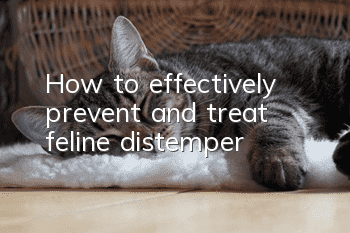How to effectively prevent and treat feline distemper?

Feline distemper is also known as feline panleukopenia or feline infectious enteritis. It is a highly contagious infectious disease that mainly occurs in kittens under one year old. The clinical symptoms include fever, leukopenia, vomiting and hemorrhagic enteritis. It is the most common and very dangerous infectious disease in domestic cats. . These issues need to be paid attention to when treating cat distemper.
It’s not just contagious between cats
In addition to the name feline panleukopenia or feline infectious enteritis, there is also another name - feline distemper. This is a severe viral infectious disease that can not only infect cats (mainly 3 to 5-month-old kittens that have not been vaccinated against feline distemper virus), but can also infect other cats and other animals such as Raccoon, ferret, raccoon cat, mink, etc. Feline distemper is caused by cats being infected by the feline distemper virus. Feline distemper virus is a parvovirus that can survive in the environment for a long time without dying. Therefore, it is difficult to kill it without strict disinfection. Others Cats are more susceptible to infection.
Feline distemper virus can be transmitted directly through infected animals and their secretions, especially feces. Since it can survive in the environment for a long time, the treatment and disinfection of pollutants is very important. Feline distemper virus can be killed by formalin, sodium hypochlorite (household disinfectant) and glutaraldehyde. Therefore, disinfectants containing these ingredients can be used for disinfection in daily life to prevent infection.
Clinical symptoms of cat plague
When cats are infected by feline distemper virus, two situations generally occur. For cats with strong body resistance, although they have been infected by the virus, they do not become ill, which means that they will not show clinical symptoms of feline distemper, but only Healthy poisonous cats.
Cats with weak body resistance are very unfortunate. They will have symptoms of feline distemper in varying degrees. In mild cases, their appetite may only become worse, while cats with severe illness will show more typical symptoms of feline distemper. The main symptoms are: fever, which can reach 40~41℃; lack of energy and anorexia, and even inability to drink water in severe cases; bile-like vomiting. Even if the cat has not eaten or drank for several days, they can still vomit or have diarrhea. Diarrhea, the degree of diarrhea is not exactly the same in every cat. Severe cases may have watery and bloody stools, and they may defecate many times a day, while cats with mild symptoms may only have unformed and pulpy stools.
Due to constant vomiting and diarrhea, sick cats will quickly develop symptoms of dehydration. If not treated in time, they will soon die from collapse; some kittens may develop neurological symptoms, and the cats will show inability to When walking normally, you may stagger and often fall down unconsciously.
If some kittens are infected with feline distemper virus before they are born, they may have retinal dysplasia, overlapping or wrinkled lesions after birth. These cats usually become blind or have very weak vision.
Easy to detect, difficult to treat
No matter what the disease is, accurate diagnosis is very important and necessary before treatment. Clinically, doctors mainly make a diagnosis by conducting various necessary examinations, and then making a comprehensive analysis based on the examination results and clinical symptoms, because in addition to feline distemper, there are other diseases that can cause clinical symptoms similar to feline distemper. , so necessary inspections are very necessary.
First, the doctor will ask the owner and the cat about their medical history and clinical symptoms. Then they will conduct routine blood and blood biochemical tests on the cat to understand whether the cat has anemia, damage to the liver, kidneys and other internal organs, but the most important and most important thing is Of diagnostic value is the detection of feline distemper virus to determine whether the cat has been infected with the feline distemper virus.
The feline plague rapid detection kit that has been successfully developed can make a more accurate diagnosis within 10 minutes, but the accuracy of this rapid detection kit is not 100%. Through the above examinations, doctors can usually make a more accurate judgment. The next step is how to treat and prevent.
Unfortunately, there are currently no very effective specific drugs for the treatment of feline plague. The main treatment principles and methods are still based on symptomatic treatment.
First of all, because the cat has vomiting and diarrhea, the doctor will advise you not to give the cat water or food based on the actual condition of the cat at that time. At the same time, the doctor will use antibiotics to control secondary infections and give the cat infusions to prevent dehydration and supplement nutrition. , for some cats with severe anemia due to blood in their stools, doctors will also give them blood transfusions. In addition, doctors will also use some antiviral and immunity-enhancing drugs to help cats get through the difficulties smoothly.
As the saying goes, three points of treatment equals seven points of care. It is also very important for the owner to take careful care of the cat during its illness and treatment. It is necessary to keep the cat warm when it is cold, and it is necessary to clean the cat in time after the body is dirty and wet due to vomiting and diarrhea. These are all It is the key to whether the cat can recover smoothly.
Prevention first, put an end to cat plague
But for cat plague, treatment is not actually the most important. The most important thing to deal with cat plague should be prevention. At present, there are feline distemper vaccines for cats in foreign countries. As long as they are used in the correct way, most cats can produce antibodies, which can effectively resist the feline distemper virus.
Cats can usually be vaccinated against feline distemper 8 weeks after they are born. One injection is not enough. Generally, 2 to 3 injections are needed.The interval between each injection is about 3 weeks. In the future, it is best to inject cats once a year to enhance the immune effect. After such measures, most cats will not be infected by feline distemper virus.
However, we would like to remind parents that all of the above operations require professional training by a pet doctor, otherwise it may cause accidents to the cat.
- Why can't cats drink milk? What should I do if my cat has diarrhea after drinking milk?
- Kitten's anus is bulging, red and swollen
- What kind of toys do pugs like?
- Why does a cat make a dove-like sound in its throat?
- What do the 12 colors of the Golden Gradient cat breed mean?
- Is it normal for a cat’s mouth to smell fishy?
- Common reactions in cats after triple therapy
- Is catnip contagious between cats?
- What causes cats to cry?
- What are the causes of cats urinating indiscriminately? What should be done to correct cats urinating indiscriminately?



